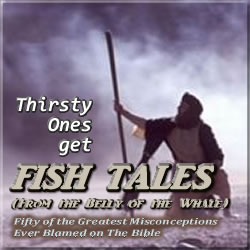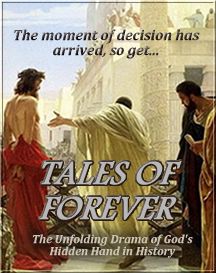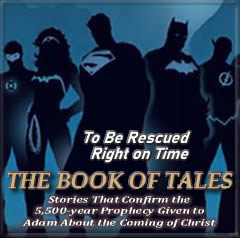Shadow and Substance
Things to Come
As has been shown in our previous discussion, one of the greatest proofs of the authenticity of the apocryphal literature is its ability to reveal a coherence within the very fabric of its textual presentation. There is an internal logic in the information found throughout the corpus of books deemed non-canonical; and there is an external logic in the consistency between the apocryphal and canonical texts. In other words, just as the accepted texts of Scripture convey a harmonious relationship, both internally and externally, the stories found in the apocryphal record bear a strikingly similar set of relationships.
An internal harmony is revealed in the case of the prophecy of The Great Five and a Days, begun in The First Book of Adam and Eve, alluded to in The Secrets of Enoch, and fulfilled in The Gospel of Nicodemus. As detached prophetic wisps, they float about as disjointed blips on the divine radar screen, but stitched together they coalesce into a genuine pattern, obvious to even the most obtuse observer of biblical timelines.
Similarly, an external harmony can be seen in the case of the divine attributes displayed by various individuals mentioned throughout the received texts—some of them heroic figures, like Enoch and Noah, and some villainous, like Nimrod and Esau. Until now, all these lives had been traditionally viewed as discordant pieces of a scattered tapestry. Upon further review, though, we found there really is a common thread that makes sense of their apparently disarrayed experiences. This thread, which can only be found in the apocryphal record, involves the strange story of the most ancient talisman known to mankind, that is, the garments of sheepskin that God made for Adam and Eve after they were expelled from the Garden of Eden.
Story Continues Below
Says Richard Price—the founder and CEO of Academia.edu—on his podcast In Depth With Academia:
Tales of Forever: The Unfolding Drama of God’s Hidden Hand in History is:
To hear Price’s book review of Tales of Forever, CLICK HERE.
To hear Kent, Zen Garcia and S. Douglas Woodward, as they discuss the 5,500-year chronology from Adam to Christ, from the perspective of The Septuagint Bible, to confirm the contents of Tales of Forever, CLICK BELOW.
Story Continues From Above
Having established this kind of logical structure, which binds the apocryphal and canonical record into a cohesive whole, I would now like to proceed further in light of this newfound awareness. Next, we will examine the extent to which the apocryphal record lends itself to deepening our understanding of the biblical doctrine known as typology. In theological terms, typology is the doctrine that expounds the idea that certain events, persons, or statements in The Old Testament are “types” that represent “shadows” that pre-figure specific attributes relating to the Advent of Christ, which, as you will recall, constitutes our primary focus in demonstrating God’s control and faithfulness. Paul articulated this idea best when he said, “Don’t let anyone judge you about food, or drink, or festivals, or new moons, or Sabbaths, which are all but shadows of things to come, but the substance is Christ.”1 This very thing, as we have already seen in the last chapter, is what happened when Annas confessed to Pilate that because they had discovered that Moses had been instructed to build The Ark of the Covenant with the dimensions of five and a half cubits, they deduced from this seemingly random bit of information that the Messiah was to arrive on the stage of world history 5,500 years after Adam. In this, both Paul and Annas were doing exactly what Jesus had done when He compared the experience of Jonah in the belly of the whale with the death and resurrection of the Son of Man.2
That said, my purpose in analyzing the role of typology in apocryphal literature—en route to laying a foundation for revealing the hidden connection between the five sacred things—is to provide answers to questions that have, down through the ages, plagued anyone attempting to either believe or dismiss the truths found in The Bible. For those who wish to believe them, I would like to offer fresh hope in their quest to ground their faith in the promises of God; and for those who wish to dismiss them, I would like to offer an alternative to their outmoded conclusions based on shortsighted interpretations.
These questions pertain to so-called “truths” offered up by various preachers that, on the surface, may sound correct, but due to stale repetitions of shallow traditional views, they instead constitute so much useless pabulum. According to Paul, God has given “gifts” to His Church in the form of apostles, prophets, evangelists, pastors, and teachers, whose job it is to administer His word, which when done faithfully accomplishes God’s stated purpose.
His people are to be equipped to do His work in order to build up the Church, the body of Christ. That way we’ll all come to such unity in our faith and knowledge of God’s Son that we become mature and full-grown in the Lord, measuring up to the complete stature of Christ. Then we’ll no longer act like children, forever changing our minds just because someone’s told us something different or because they deceived us by making a lie sound like the truth.3
All too often, however, humans want the purpose of God’s Church to revolve around them and their needs, that is, to heal them, bless them, prosper them. But Paul insisted that the true purpose of these gift ministers is to bring the scattered individuals who comprise the Church into a “unity of faith,” which can only come from a “knowledge of God’s Son.” Therefore, it behooves those who are attempting to become part of this body of Christ to find someone who can adequately inform them about what the Scriptures say about faith in Jesus Christ. Sadly, though, much of today’s Bible teaching focuses on catering to the human needs of its parishioners as opposed to God’s specified desire to build a body of believers who truly understand Who Jesus is.
Part of the problem, as I see it, rests squarely on the shoulders of those individuals who—while claiming to be gift ministers of God’s word—willfully insist on feeding their unsuspecting congregations the same old stories, regurgitated from their pet Bible commentaries. Never mind that intelligent people with the courage to ask difficult questions prefer meaningful answers rather than trite homilies. Never mind that these so-called “gift ministers” seem to be so oblivious to the inconsistencies in their own teaching of God’s word, in spite of the glaring contradictions that their worn out clichés attempt to gloss over. We are simply expected to marvel at their well-intentioned genius while we politely resist the urge to ask any question that might make our fellow saints think we have lost faith in the traditional interpretation of the brethren.








